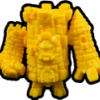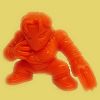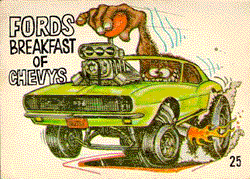Whether the Non-MUSCLE sculpts were not filling properly due to the MUSCLE plastic, or the Non-MUSCLE sculpt molds/cavities became damaged, the next question is whether there is a realistic possibility that Bandai resorted to cavity blocking.
Everything I've read on the Web seems to indidcate that cavitiy blocking is taboo and a horrible solution to any multi-cavity mold problems.
However, companies do resort to cavity blocking under extreme and special circumstances.
Furthermore, as Jkaris speculated, it seems that when cavity blocking is employed, a cavity is blocked at the gate, rather than the runner (as I speculated). Blocking a cavity produces enough trama, if one were to plug the runner, the thing would probably explode!

Tooling Corner: To block, or not to block.
How do I block off a cavity?” is in one sense a silly question, yet in another it is perfectly logical. Experienced folks in the industry would never ask a question like this in the first place.
...
[The boss] has been informed (for this example) that the part in cavity number 5 in an eight-cavity mold got stuck. The part and cavity got crushed when the machine closed with full clamp. For this example we’ll ignore the fact that the setup allowed this damage to occur because the mold protection system was set too high, disabled, or ignored. Here’s his logic: Block off the mortally wounded cavity and run on seven cavities to complete the run and meet the JIT delivery deadline. Therefore, asking how to block off a cavity is a logical and valid question.
...
Now to the technical side: Unfortunately, people do block off cavities. But, for some reason, they never take into account that the shot size got proportionately smaller from this action. It is like trying to push 8 quarts into a 7-quart basket. It first unbalances the mold—more force will be exerted at the peak of injection on one section of the mold and not on another because of the blockage. This is why blocked cavities usually result in an increase in flash on the remaining cavities.
Increases in scrap also prolong the run time. Unbalanced molds come out of alignment. You can see the wear on the guide pins by running unbalanced molds. Over-packing not only causes flash, it also changes molding stresses. Molding stresses determine dimensions. Our off-spec parts also increase run times until this situation is remedied. This means you’ve also messed up your Cp (process) and CpKs (process constants).
...
There is also the issue of pride in workmanship (not yours, the mold builder’s). You’ve pounded something into the gate, then removed it and sent the mold off for repairs. Little did you know that pounding something in then removing it has opened the gate size.
...
So, when and how do you block a cavity? Don’t!! Fix the mold. There are rare instances that can recommend this practice, but I’ll keep them secret along with the technique for not losing money or destroying the mold. If you block a cavity you might as well burn your paycheck. At least that way your company won’t lose too much money.
A couple thoughts about the "special circumstances and secret technique."
1) The Bandai/Mattel situation was special. Since Mattel wasn't concerned about the Kinnikuman storyline, a missing sculpt was not a big deal for the MUSCLE toyline.
2) Since Bandai had already used the family molds to make the Kinkeshi line, plugging certain cavities and permanently "ruining" the molds wasn't a concern. I suppose Bandai figured they would never need the Non-MUSCLE sculpts again. (And it appears that they didn't.)
Other supporting data that the molds were permanently blocked is the missing sculpts in the colored wave and the reissues.
3) The author mentions a technique that would not destroy the mold. My uneducated guess would be that he is referring to blocking another cavity to maintain mold balance thus reducing stress on it. As the MUSCLEs were mass produced, undue stress on the mold would have been a concern.
So it is highly likely that Bandai took this precaution by simply blocking off both of the sculpt molds.
There may have even been instances when Bandai was forced to block of two additional cavities on the other end to insure overall balance, but that is just speculation.
However, once again it seems it is reasonable to assume that Bandai did indeed resort to cavity blocking to produce the MUSCLE toyline.





















